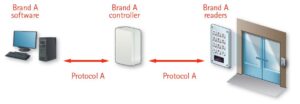
It is no exaggeration to say that network video has revolutionized the video surveillance market. Now the access control industry is on the verge of a similar development. Once again, it is the transition from analog to IP-based systems and with it the adoption of open standards which provides new opportunities and stimulates market growth.
Since the introduction of the first network camera in 1996, the market share of IP-based video surveillance systems has increased year by year. Today, network video solutions offer a host of benefits and advanced functionalities that cannot be provided by analog video surveillance technology.
There are a number of common misconceptions as the physical access control industry undergoes a similar transition from analog to IP-based technology. In the following, the top 3 of these myths will be addressed.
Myth #1 – It’s not worth upgrading existing analog systems to IP-based technology
A typical analog access control system is dependent on having each device – card reader, handle, door lock, etc. – hard wired with RS-485 cable into one central unit or central server. Besides being proprietary systems, which confines the end user to one single provider of hardware and software, these solutions often tend to be very complex and require expert personnel to handle installation and configuration.
Furthermore, when expanding analog systems the process is complicated by the need to consider that a typical central controller is built to accommodate a certain maximum number of doors, normally 4, 8, 16 or 32. Not only does this limitation make the system inflexible but also makes it difficult for the end user to match his requirements with products available, e. g. if there is a need for access control at for example 9 or 17 doors. This lack of flexibility also brings high marginal costs, which can make the addition of one extra door unjustifiably expensive.
Upgrading an analog access control system to IP-based technology therefore allows for more flexibility while lowering costs as the system needs to be expanded to include additional doors. IP networks can be used for more than one application. This way different security systems can use the same infrastructure and can be integrated with each other. Often remote monitoring and management of security systems is a key requirement. This can be easily implemented with IP-based solutions which feature web-based console access.
Myth #2 – Access control systems are only for large installations
Analog access control products and systems are normally designed and optimized for large installations with a lot of doors and maybe thousands of credentials (cardholders). The actual market looks very different. The average installation consists of 7 doors with less than 130 credentials. Only about 20% of the installations have more than 10 doors.
Without the need for hard wiring to a central control unit or central server, IP-based access control systems enable installations that are very flexible and scalable. This means not only a more versatile solution, but also a more cost efficient one. Freed from the constraints of enlarging the system in certain multiples, a network-based solution can – should it be necessary – be enlarged by one door, and one reader, at a time.
Additionally, IP-based technology enables “edge” solutions. An edge solution has one controller for each door, which is then connected to the existing local Ethernet through a regular network switch without the need for a central server for management. Since IP networks now are ubiquitous in offices, stores, factory plants and similar facilities the cost of adding an IP-based door controller would be minimal, as opposed to multiple serial connections wired back to a central server. Cabling work can be even further facilitated. By employing a PoE (Power over Ethernet) supported controller at each door the need for a separate power cable is eliminated, thereby reducing the total installation cost and time compared to that of an analog access control solution.
Myth #3 – Access control systems are proprietary solutions that can’t be integrated with other security systems
Very much like in the video surveillance market the shift from analog to IP-based technology in the access control industry will cause a transition from proprietary systems to open solutions. And these solutions will most likely be based on international industry standards.
Open solutions and standardized interfaces are a prerequisite in any industry that wants to establish its own equivalent of “plug-and-play”. There are many gains from such a development also in access control. It will allow end users to freely pick and choose between components – reader, door controller and software – that best satisfy their needs and preferences. This freedom of choice makes the system future-proof and means the end user no longer has to rely on a single brand or supplier. Equally important, it can also enable integration with other security related systems and third party applications, without the need for costly hardware boxes to provide the “bridge” between the different systems. For example, a very common request is to integrate physical access control with video. People entering a building will automatically trigger a camera; the live images can then be used for investigation of incidents or identity control.

In the network security systems market there is already a clear trend to develop open or standardized application platform interfaces (APIs), which can be used by all competing market participants on fair, reasonable and non-discriminatory terms. Naturally, this will increase supply and promote competition and bring a new level of innovation to the industry, while simultaneously making it even easier for end users, system integrators, consultants and others to take advantage of the different possibilities offered by IP-based solutions.
For example, the Open Network Video Interface Forum (ONVIF), which is a global and open industry standards body with the goal to facilitate the development and use of IP-based security products, announced in 2010 an extension of the organization’s scope of standardization to cover physical access control. Ideally, access control devices from manufacturers that comply with the ONVIF standards will in the near future interoperate effortlessly and seamlessly with each other, as well as with other video surveillance products and systems conformant with the standard.
Future outlook
IP-based access control systems will comprise more than 35% of the market in terms of shipments by 2016. A key factor will be that new buildings are increasingly being equipped with IP-based building control systems. This provides the basis for integration of previously often separate systems such as access control, intrusion detection, fire alarms or video surveillance.
Open standards and the ability to base different security systems on the same IP network architecture allows installers to build solutions based on products from various manufacturers. This way they can better meet customer demand, price projects more competitively and offer custom solutions to particular installation challenges and requirements. End users benefit from a future-proof and adaptable technology that can easily scale to their growing needs without being locked into any one manufacturer.
Source: a&s Magazine



































































